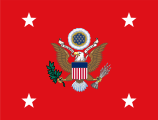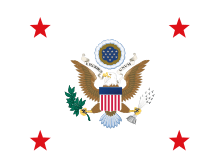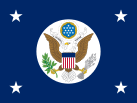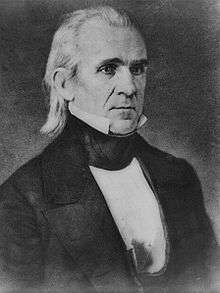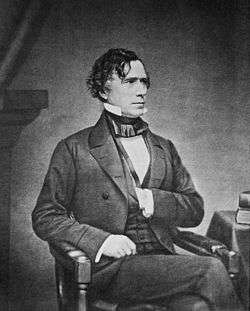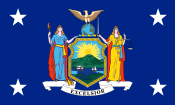William L. Marcy
| William Marcy | |
|---|---|
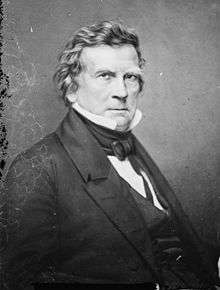 | |
| 21st United States Secretary of State | |
|
In office March 7, 1853 – March 6, 1857 | |
| President | Franklin Pierce |
| Preceded by | Edward Everett |
| Succeeded by | Lewis Cass |
| 20th United States Secretary of War | |
|
In office March 6, 1845 – March 4, 1849 | |
| President | James K. Polk |
| Preceded by | William Wilkins |
| Succeeded by | George W. Crawford |
| 11th Governor of New York | |
|
In office January 1, 1833 – December 31, 1838 | |
| Lieutenant | John Tracy |
| Preceded by | Enos T. Throop |
| Succeeded by | William H. Seward |
| United States Senator from New York | |
|
In office March 4, 1831 – January 1, 1833 | |
| Preceded by | Nathan Sanford |
| Succeeded by | Silas Wright |
| 8th Comptroller of New York | |
|
In office February 13, 1823 – January 21, 1829 | |
| Governor |
Joseph C. Yates DeWitt Clinton Nathaniel Pitcher Martin Van Buren |
| Preceded by | John Savage |
| Succeeded by | Silas Wright |
| Personal details | |
| Born |
William Learned Marcy December 12, 1786 Sturbridge, Massachusetts, U.S. (now Southbridge) |
| Died |
July 4, 1857 (aged 70) Ballston Spa, New York, U.S. |
| Resting place | Albany Rural Cemetery |
| Political party |
Democratic-Republican (Before 1825) Democratic (1825–1857) |
| Spouse(s) | Dolly Newell |
| Children | 3 |
| Education | Brown University (BA) |
William Learned Marcy (December 12, 1786 – July 4, 1857) was an American lawyer, politician, and judge who served as U.S. Senator, Governor of New York, U.S. Secretary of War and U.S. Secretary of State. In the latter office, he negotiated the Gadsden Purchase, the last major acquisition of land in the continental United States.
Born in Southbridge, Massachusetts, Marcy established a legal practice in Troy, New York after graduating from Brown University. He fought in the War of 1812, serving as a captain of volunteers. Politically, he aligned with the Bucktail faction of the Democratic-Republican Party and became a leading member of the Albany Regency. As the Democratic-Republicans fractured in the 1820s, he became a member of the Democratic Party. Between 1821 and 1831, he successively served as Adjutant General of New York, New York State Comptroller, and as an associate justice of the New York Supreme Court. In 1831, the New York legislature elected Marcy to the U.S. Senate, and he held that position until 1833, when he became the Governor of New York. He served three terms as governor until his defeat in 1838 by the Whig nominee, William Seward.
He served as Secretary of War under James K. Polk from 1845 to 1849, overseeing the Mexican–American War. After leaving the Polk administration, he resumed the practice of law and became a leader of the "Soft" Hunker faction of the New York Democratic Party. He returned to the Cabinet in 1853, serving as Secretary of State under Franklin Pierce. In this role, he resolved a dispute about the status of U.S. immigrants abroad and directed U.S. diplomats to dress in the plain style of an ordinary American rather than the court-dress many had adopted from Europe. He also negotiated a reciprocity treaty with British North America and the Gadsden purchase with Mexico, acquiring territory in present-day Arizona and New Mexico. He left office in 1857 and died shortly thereafter.
Early life
William Learned Marcy was born in Southbridge, Massachusetts. He graduated from Brown University in 1808, taught school in Dedham, Massachusetts[1] and in Newport, Rhode Island. He studied law with Troy, New York attorney William L. Bliss, was admitted to the bar in 1811, and began a practice in Troy. Marcy served in the War of 1812, serving first as a lieutenant and afterwards as a captain of volunteers. On October 22, 1812 he took part in the storming of the British post at St. Regis, Canada.
Afterward he served as Recorder of Troy for several years. As he sided with the Anti-Clinton faction of the Democratic-Republican Party, known as the Bucktails, he was removed from office in 1818 by his political opponents. He was the editor of the Troy Budget newspaper.
On April 28, 1824, he married Cornelia Knower (1801–1889, daughter of Benjamin Knower) at the Knower House in Guilderland, New York. They had three children -- Samuel (1820-1862), Edmund (1832-1853), and Cornelia (1834–1888). Samuel March was a United States Navy officer who was killed on board the USS Vincennes during the American Civil War. Edmund Preble was ill when he died on board the USS Preble while being transported to the Azores in the hopes of regaining his health. Cornelia Marcy was the wife of Edmund Henry Pendleton (1845-1910), a Union Army veteran who later became a successful author.
State politics

Marcy became the leading member of the Albany Regency, a group of Democratic politicians who controlled State politics between 1821 and 1838. He was Adjutant General of New York from 1821 to 1823, New York State Comptroller from 1823 to 1829, and an associate justice of the New York Supreme Court from 1829 to 1831.
In 1831, he was elected U.S. Senator from New York by the state legislature as a Jacksonian Democrat, and served from March 4, 1831, to January 1, 1833. He resigned upon taking office as governor, to which position he was elected in 1832. He sat on the U.S. Senate Committee on the Judiciary in the 22nd Congress. Defending Jackson's nomination of Martin Van Buren as minister to the United Kingdom in 1832, Marcy used the phrase "'to the victor belong the spoils," from which the term spoils system is derived to refer to patronage political appointments.[2]
Marcy was elected as Governor of New York for three terms, from 1833 until 1838. In 1838, he was defeated by Whig William H. Seward, which led to a radical change in state politics and then ended the Regency. To the abolitionists who questioned the candidates for governor, Marcy was considered a "doughface," a man with Southern sympathies. He was well aware of the importance of Southern cotton and trade for New York state, both as a major part of exports from New York City, and to the textile mills of upstate that processed cotton from the Deep South.
Marcy was appointed as a member of the Mexican Claims Commission, serving from 1839 to 1842. Later he was recognized as one of the leaders of the Hunkers, the conservative, office-seeking, and pro-compromise-on-slavery faction of the Democratic Party in New York.
Federal politics
Marcy served as United States Secretary of War in the Cabinet of President James K. Polk from 1845 until 1849, when he resumed the practice of law in New York. After 1849, Marcy led the "Soft" faction of the Hunkers that supported reconciliation with the Barnburners. He sought the Democratic presidential nomination in 1852 but was unsuccessful, in part by "Hard" opposition led by Daniel S. Dickinson.
Marcy returned to public life in 1853 to serve as United States Secretary of State under President Franklin Pierce. On June 1 of that year, he issued a circular to American diplomatic agents abroad, recommending that whenever practicable, they should appear in the simple dress of an American citizen. This directive created much discussion in Europe, where diplomats typically wore court dress. In 1867, Marcy's recommendation was enacted into law by the US Congress.[3]
Marcy resolved the Koszta Affair (1853), related to detention of an unnaturalized American resident by Austria, gaining his freedom. He negotiated the Gadsden Purchase from Mexico in the Southwest, the last major land acquisition by the United States within its continental territory. It added land to what are now the states of New Mexico and Arizona. With a southern route of territory all under United States control, southerners worked to promote a railroad from Texas to San Diego but were not successful.
Other affairs that demanded Marcy's attention were a Canadian reciprocity treaty, Commodore Matthew C. Perry's negotiations for naval and trade access with Japan, a British fishery dispute, and the Ostend Manifesto.[4]
Marcy died at Ballston Spa, New York on July 4, 1857.[5] He was buried at the Rural Cemetery in Albany, New York.[6]
Legacy and honors
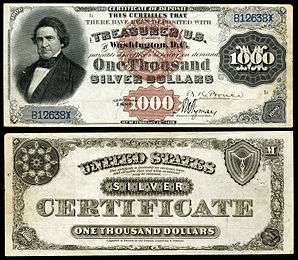
- The United States Revenue Cutter William L. Marcy, launched in 1853, was named in his honor.[7]
- His portrait appeared on American paper currency, the U.S. $1000 Silver Certificate, issued between 1878 and 1891.
- Mount Marcy in Essex County, at 1629 meters the highest peak in New York, was named for him.
- The Town of Marcy in Oneida County was named for him.[8]
- The Marcy Projects, public housing in Brooklyn, New York, were named for him.
References
![]()
- ↑ History of Dedham, Massachusetts by Frank Smith. The Transcript Press. 1936
- ↑ "1314. Marcy William Learned (1786-1857). Respectfully Quoted: A Dictionary of Quotations. 1989". Bartleby.com. Retrieved 2010-09-05.
- ↑

- ↑

- ↑ "Death of Hon. W. L. Marcy". New-York Daily Tribune. New York City. July 6, 1857. p. 4. Retrieved 27 October 2016.
- ↑ Sec. 62, lot 94, Albany Rural Cemetery, Menands, Albany, NY., Wilson, Scott. Resting Places: The Burial Sites of More Than 14,000 Famous Persons, 3d ed.: 2 (Kindle Locations 30001-30002). McFarland & Company, Inc., Publishers. Kindle Edition.
- ↑ "Marcy, 1853" (PDF). U.S. Coast Guard History. U.S. Department of Homeland Security. Retrieved 27 October 2016.
- ↑ Gannett, Henry (1905). The Origin of Certain Place Names in the United States. U.S. Government Printing Office. p. 199.
Further reading
- Spencer, Ivor Debenham, The Victor and the Spoils: a Life of William L. Marcy, Brown University Press (1959).
Sources
- United States Congress. "William L. Marcy (id: M000127)". Biographical Directory of the United States Congress.
- "William Learned Marcy". Secretaries of War and Secretaries of the Army. United States Army Center of Military History. Retrieved 27 October 2016.
- "Marcy, William Learned". The Political Graveyard. Lawrence Kestenbaum. Retrieved 27 October 2016.
- "Descendants of Benjamin Knower of Roxbury". Knower family in America. rootsweb. Retrieved 27 October 2016.
External links
| Political offices | ||
|---|---|---|
| Preceded by John Savage |
Comptroller of New York 1823–1829 |
Succeeded by Silas Wright |
| Preceded by Enos T. Throop |
Governor of New York 1833–1838 |
Succeeded by William H. Seward |
| Preceded by William Wilkins |
United States Secretary of War 1845–1849 |
Succeeded by George W. Crawford |
| Preceded by Edward Everett |
United States Secretary of State 1853–1857 |
Succeeded by Lewis Cass |
| U.S. Senate | ||
| Preceded by Nathan Sanford |
U.S. Senator (Class 3) from New York 1831–1833 Served alongside: Charles E. Dudley |
Succeeded by Silas Wright |
| Party political offices | ||
| Preceded by Enos T. Throop |
Democratic nominee for Governor of New York 1832, 1834, 1836, 1838 |
Succeeded by William C. Bouck |

